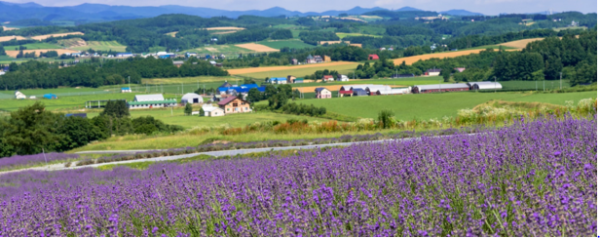Furano – for lavender and melons – GEORGE BRAINE
 Sapporo, the capital of Hokkaido, Japan’s northern island, is a flat, sprawling city, surrounded by low hills. The downtown area, with classy department stores, high end dining, and tree lined boulevards, is lovely. But the outskirts are not attractive: mile after mile of car dealerships, used car lots, and pachinko (gambling) parlors.
Sapporo, the capital of Hokkaido, Japan’s northern island, is a flat, sprawling city, surrounded by low hills. The downtown area, with classy department stores, high end dining, and tree lined boulevards, is lovely. But the outskirts are not attractive: mile after mile of car dealerships, used car lots, and pachinko (gambling) parlors.
Beyond the city, Hokkaido’s countryside is breathtaking. Forests, rolling hills, farms, salmon streams, fast flowing rivers, crystal clear lakes. The forests are rich in bear, deer, foxes, and smaller creatures. The beaches are clean, and although too cold for bathing most of the year, are deserted and ideal for beach combing. The surrounding seas supply plentiful fish and crustaceans, which the Japanese love to eat raw, steamed or grilled.
We were hunkered down in Sapporo for months, first by winter and then by Covid-19, and were impatient to travel. Infection numbers were down, our Covid fatigue needed a cure, and Furano was the obvious choice. I had been there three years ago and loved the place.
Hokkaido’s economy depends on farming, fisheries, and forestry, but Furano is best known for its lavender fields and melons. The flatness of the terrain is, in a mountainous island, quite astonishing. The hills can be seen all round in the far distance, but what lies in between is farm after farm, in near-perfect rectangles, swathes of gold (ripening wheat) and shades of green – rice, corn and onions. In between are the numerous greenhouses for the precious melon. Copses of trees dot the landscape. Irrigation channels spread the water from mountain streams throughout the agricultural fields.
Hokkaido’s agriculture was developed under American guidance, so the farm houses, the barns, and the silos have a distinctly
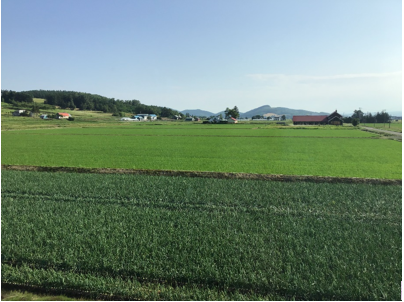
American appearance. But, these are not humongous farms like in the USA, but much smaller ones, the farmer and his family living on site, in houses that add much color to the landscape. In Japan, every aspect of farming – tilling, planting, weeding, spraying, harvesting – is mechanized, from two-wheeled tractors to tankers with extended arms that spray water onto the onion fields.
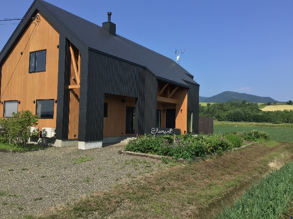
The Bed & Breakfast, “Element”, was in the midst of an onion field. During my walks, I saw fields basking in the glorious summer sunshine and the farmers going about their work diligently. The Japanese value aesthetics highly, and this extends to the farms, which are kept in near perfect order, to blend easily with the landscape and the neighboring farms. The irrigation ditches are cleared of sludge, and the crystal clear water flows smoothly. I read that water distribution is harmonious and well regulated.
Ken, whose dad is Australian and the mother is Japanese – they met while skiing in New Zealand! – and his Japanese wife Chia own and run Element. They had lived in a southern island but moved to Furano ten years ago, and started Element five years back. Ken designed the lovely building, all the wood being recycled. The fruits and vegetables served at breakfast are from their kitchen garden. During our stay, there were no other guests (they had four rooms), so times must be tough for them.
Furano is most famous for its lavender fields, which, on our last visit, were packed with tourists. This time, with the airport closed for international flights, only Japanese visitors were around. To enjoy them the most, one must spend time with the lavender, strolling among the fields, inhaling the scent deeply, or sit at a nearby bench and simply gaze, while butterflies flutter and bees go about their work. A cone of Japan’s heavenly soft-serve ice cream, lavender flavored, of course, in hand, adds to a sense of calm that is precious during these troubled times.
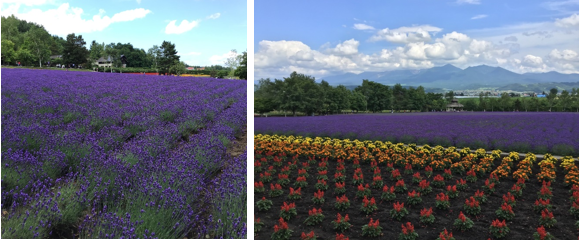
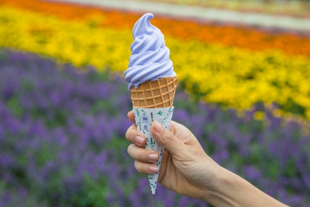
Lavender is big business. Mainly used in the manufacture of perfume, lavender has also been applied to a mind boggling number of products, ranging from sachets of potpourri, to oil, soap, candles, pillows, hand cream, and tea. Lavender flavored ice cream and wine are also big hits.
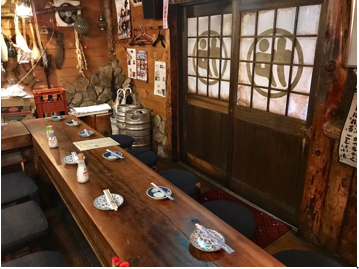
One evening, we had dinner at an izakaya, a type of small neighborhood pub/eatery popular in Japan. Usually run by a husband and wife couple, or a chef and an assistant or two, they have a vast range of dishes on the meu, and a loyal clientele. One pushes the sliding door to a side, parts the half curtain to peer and step-in, to be greeted with “irasshaimase” meaning “welcome, please come in”. Robata, the izakaya in Furano where we ate, is a tiny, quirky place, where the chef owner is assisted by a younger man. A weird collection of artifacts hang from the ceiling, and all around are bottles of liquor, masks from Noh drama, endless menu items with price tags, and coolers. Only the square seating area is in any order, chopsticks balanced on tiny, colorful plates, all social distanced. Traditional Japanese music (high pitched wailing, usually), plays in the background. Everything is covered in a sheen of dust, but who cares: we came to eat and drink.
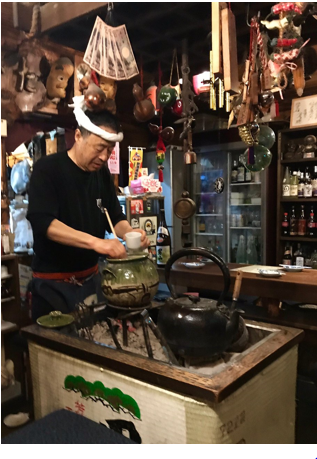
Upon being seated, wet towels are passed around, and small bowls of edamame (boiled soybeans in the pod) served. We take our time over ordering, because the meus are many and varied, but eventually go with the chef’s recommendations – cold draft beer, sashimi, cold tofu, grilled fish, and yakitori (grilled chicken on skewers). Izakayas are boisterous places, but tonight the mood is somber, Covid being not far from everyone’s mind. The chef keeps on a bantering with the customers (the only gaijin (foreigner), me, being a point of interest), soft cries of “kanpai” (cheers) are heard, and we savor the warm ambience. The bill is not itemized, instead rounded to the nearest thousand. We step out to a cool evening, the bright lanterns leading the way magically down a narrow lane.
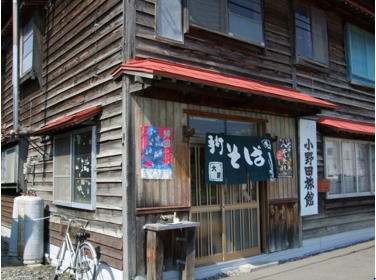
Another day, away from Furano, we come across an old soba place in a rustic area. Soba is buckwheat noodle, served in a warm broth in winter and cold in summer, usually with tempura – vegetables, fish or meat battered and deep fried. Cold soba and vegetable tempura are among my favorite Japanese dishes.
While waiting our turn to get in, another customer told us that the restaurant, Onada Soba, was the setting for a popular TV drama series in the early 1980s named “North Country”. When we entered, I wondered if anything had changed since then. The walls had hundreds, if not thousands, of business cards and flight boarding card stubs left by fans from all over Japan and elsewhere, some going back nearly 40 years. A coat of dust covered everything. An elderly man did all the cooking, helped by his wife who waited and washed up. The menu had only four items, and we ordered cold soba with onion tempura, and the waitress told us that two servings of tempura, not three, would be enough. When the meal arrived, I saw why. The tempura was an extra-large portion, fried to a golden sheen. With a generous serving of green tea, I enjoyed perhaps the best ever soba meal.
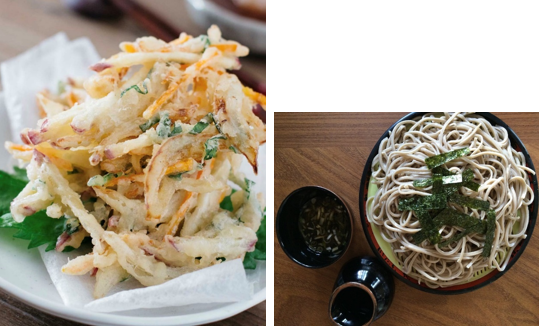
Now for the melons. The Japanese are fond of water melon, cantaloupes, and honey dew. Furano cantaloupes are highly prized and are given as gifts. I’ve seen melons priced at US$50, but we didn’t have to pay that much for the sweetest melons. Back in Sapporo, we gave one to our neighbor, and, with a delighted smile, she ran to place it on her late husband’s altar before consuming it later.
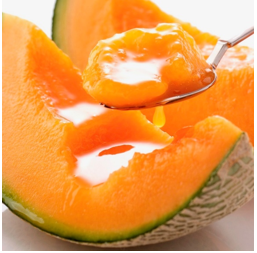
We returned from Furano relaxed and rejuvenated, longing to go back in a few weeks.
GEORGE BRAINE
